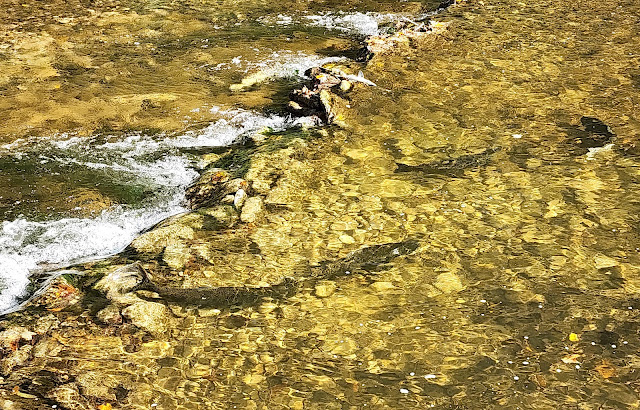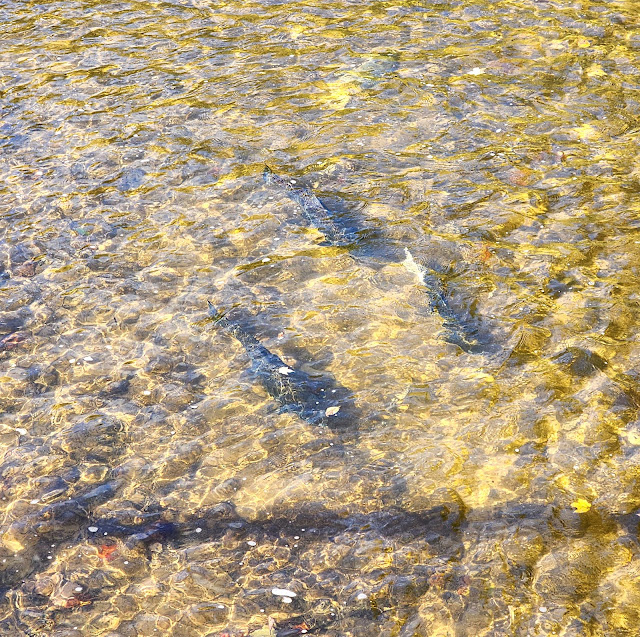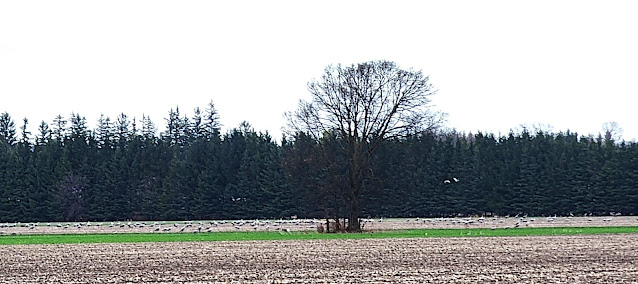The forecast was overwhelming, the most snow in years, as much as all last winter combined! But meteorologists do tend to exaggerate. We got about 2" so far but of course I may be wrong and it may accumulate over the next few days to reach the forecast potential of 75 cm! In the meantime, here are a few paired pictures to show you how our world has changed.
The view out the back window.Saturday, November 30, 2024
Thursday, November 28, 2024
Christmas Cards
Do you still send Chris6tmas cards? We may be old fashioned, but we still send out Christmas cards every year. It provides a way to stay in touch with friends and relatives you hardly ever see - or in our case that we never see! It always seems like a personal way to put some meaning into the holiday season.
Tuesday, November 26, 2024
The Rainy Days of November
November always seems to bring rain and cold. I don't mind rain, though it keeps me inside, and I don't mind cold - but not cold and wet together! I always looked forward to winter, once things are frozen, but of course now that I'm in a wheelchair I have to change my assessment of the weather - if the forecast turns out to be accurate!
And on top of the wet for the last five days, the forecast does show some of that white stuff for later in the week. It's late for us, but I see by your blogs that places like Maryland, 500 km. to the south, already have snow.Sunday, November 24, 2024
Winter Birds?
Our bird feeders have now been loaded up with seed and the other day I spotted my first two winter birds at those feeders. These are terrible pictures, but I'm hoping they presage a winter with lots of birds!
Friday, November 22, 2024
I Can't Believe It!
I can't believe it but the weather is so mild here in late November that I rode downtown or home from downtown twice this week! Usually we've had at least a couple of major snowfalls by this time, but not this year. I'm hoping for a mild winter, even if the skiers want snow!
This was the harbour on Monday, my friends bench at the left under one of the few trees. Can you spot the swans? I don't think I've ever seen swans in this harbour before.I got a good deal closer on this bright sunny day. They raised their heads and as you can see by their orange beaks, these are Mute Swans. They do tend to hang around rather than migrate. At any rate, it was a remarkable 8°C that day.
Wednesday, November 20, 2024
Monday, November 18, 2024
Salmon, Round Two
After quite a few pictures from the bridge, I moved over to the side for a different view. I could watch as the fish approached that low line of rocks and with a swish of their tail, splashed up over it. In the wild and at the fish ladder I've seen salmon leap over much higher barriers.
Again I watched as groups of salmon seemed to follow one another.I was certainly getting the impression that there were a lot of migrating fish this year!
Every now and then I'd get a good look at individual fish with their rainbow of colours.
These fish will continue upstream to spawn, both in smaller spawning channels developed along the edges of the river, and in Weavers Creek, a tributary. But none of them get past Inglis Falls, a couple of kilometres to the south.
Saturday, November 16, 2024
Migrating Salmon
Every fall we try to get to Owen Sound during the salmon migration in late September or early October. It's easy to spot the salmon, and lots of fun. For us it celebrates the success of the Sydenham Sportsmen Association. They run two fish hatcheries and stock thousands of tiny fish each year. The fish ladder they built around the mill dam in Owen Sound was the first in Ontario. We get to see some of those fish when they return to spawn.
Our favourite viewpoint is the bridge over the Sydenham River, right in the middle of Harrison Park.You can look right down between the supports of the bridge railing and see the fish swimming up against the current.
They had to struggle a bit to get over the low barrier 50 feet downstream, but they had little trouble.
Thursday, November 14, 2024
A Busy Week!
We've had a busy week! Tuesday I had a dental apt. and took advantage of Mrs. F.G. driving me downtown to also go to the library, so I've got a group of books to keep me busy for the week. The temperatures have dropped down into the single digits so it's rather chilly riding a wheelchair around town! I was glad to find her waiting for me afterwards as well.
Yesterday I had my regular weekly physio appointment, and after that went out to a meeting of the Accessibility Advisory Committee which I sit on, held in the council chambers. I'm not sure how much we accomplish, but it's certainly interesting. We're slowly working towards a program to encourage downtown businesses to at least make their front entrances accessible.
Today I go down for my regular weekly lunch with the guys - all former dedicated volunteers for our local Bruce Trail Club. We meet at McGinty's which is a breakfast and lunch cafe, and chat about anything under the sun for and hour or more. This group has been going about 10 years now, evolving over that time as restaurants closed during the pandemic at different times, and as new members joined our group while others left.
There's a local small transit service I've probably mentioned before, intended for the disabled in town, and intended mainly for medical apts. I qualify obviously, and used it yesterday to go to physio and from there to my committee meeting. It certainly saves Mrs. F.G. some driving.
Monday, November 11, 2024
Visiting an Apple Orchard
Before I wander to other topics for my posts, I'd like to take you back to two things we did in early October. Come with me today to a large modern apple orchard on the Open Fields Farm T our in the township just to the east of us here. Four farms put on tours as well as an apple packing facility.
Perhaps first I should say a word about why we grow so many apples here. Apples around Ontario are generally grown close to the Great Lakes because the temperature of the water changes more slowly than the temperature over land. This tends to delay blossom opening until the risk of frost is past. All the major orchards here are located between the Niagara Escarpment and the bay, which provides a boundary for the zone of more moderate temperatures. Close to the shoreline is also a zone of sandy soils which are the best; apple trees don't like wet feet!
The farm we visited is Ardiel Acres, where the orchards are a mixture of older style large trees, and these narrow rows of high-density plantings. There were lots of apples ready to be picked when we were there.This farm has no retail outlet, rather the apples go to a local apple packing facility that will send them on for juice-making or retail sales in stores, depending on quality.
One of the family farmers explained some basics to the small crowd, and thankfully I could get out and ride around on the gravel. Apples are picked directly into large red apple crates like those in the background, mostly by seasonal farm workers.
Picking the apples requires specialized equipment since the trees are about 15 feet high. Good old-fashioned ladders are still used for the large trees, but in hi-density orchards more mechanized equipment can be used.
This enormous piece of machinery is what modern apple picking looks like here. Apple pickers ride both sides of the machine, standing at different heights, so the entire tree gets picked on both sides. And no-one drives this machine; it's programmed to drive itself down the rows. We were told it is accurate to with half and inch at the end of each row!
There was also a little fun to be had at this family event, though I didn't see anyone playing tic-tac-toe.
The blow-up balloons were popular though, and when the little kids were finished Mrs. F.G. slipped in to get me a new hat! What do you think?
Saturday, November 9, 2024
The Seasons Are Changing!
Today I want to acknowledge the changing seasons, for they've changed suddenly and significantly for me. I can't quite believe it but I've made it all the way through October and into November while still going out to ride downtown. We were still getting days of 20°C right to the end of October! Most trees are now leafless and it's now cold! It's November!
The only trees out back that still have leaves are the Norway Maples, here on the left and right. I'm not fond of Norway Maples, since they're non-native, but here they're better than the White Ash which were all infected with Emerald Ash borer. And those are my weights, lest you think I'm doing nothing while sitting in front of our living room window every morning.Thursday, November 7, 2024
More Sandhill Cranes
We turned around and headed back home at this point, wondering if we would see any more Sandhill Cranes. Well, we did! But they were a very long distance away, like a grey line on the far side of the field.
We stopped to get a shot of these three cranes fairly close, though they took off flying.
These final three photos show a long line of Sandhill Cranes gathered on the far side of the field, not much to look at but a record for us. We drove home happy after a good day hunting for the remarkable Sandhill Cranes.



















































